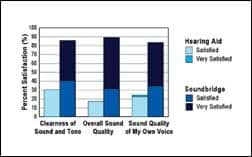
|
| Renee Erno, BS, BC-HIS, is senior associate manager of American Hearing Aid Associates (AHAA), West Chester, Pa. She works out of her office in Las Vegas. |
Our “typical” presentations are not working! Industry statistics show that we are not doing well at all. Our close rate is 60%. Our return/exchange rate is 27%. Our sales-to-new-patients average is 43%, and only 58% of patients we do fit wear their hearing aids regularly.
These statistics point out a need to change our presentations. We need a renewed and expanded focus on the patient’s welcome and history, administration of various hearing tests, explanation of the results, demonstration and presentation of choices, and making the impression we give to the patient, as well as the supporting documentation and contract. In short, we need to be more persuasive.
10 Traits of a Highly Successful Presentation
1) Prepare for the office visit.Successful presentations begin before patients come to your office. For example, in setting appointments, stress the need for them to bring along a third party or significant other.
Ensure that your facilities are clean and neat and that your staff is friendly, welcoming, and informative about the process. Have all of the “tools” available that you will need, including forms, impression materials, and demonstration aids. This helps build trust and confidence that you are a competent and prepared professional.
2) Welcome and build rapport and trust. Building rapport and trust is critical to a successful presentation. Start with the proactive and positive attitude that you are going to help patients change their lives for the better. Smile and greet patients and their companions warmly and sincerely. Speak directly to the patient; you will address the third party later.
Find out why the patient is in your office today. Have patients set their goals for the visit. One place to start is to ask what kinds of social benefits they are seeking. Move patients to admitting and owning their hearing loss. They, like you, must be concerned about their disability. Get them to describe their discomfort and awkwardness. Identify key environments or situations where the patient wants to communicate more effectively.
Confidently establish your role in how the practice will help them hear better. Tell them about your education, training, and experience. The goal is to build and gain trust that you are competent and prepared to help, and to establish yourself and your practice as the reliable resource and solution for their hearing problems.
In building trust, take care to listen to their real interests. Ask “have” and “what” open-ended questions to discover needs and get them talking. Summarize and confirm what they have said. Tell them how you have helped others like them, and focus on their loss and the need for a solution. Describe your purpose, the process, and what end-result is likely.
Then, fit your subsequent presentations to their personality types and their expectations. Remember that you must appeal to patients’ emotions and that the decisions to take action for better hearing must come from the patient.
3) Define and conduct the tests. Of course, in conducting the various hearing tests, you want to rule out visible congenital or traumatic deformities in the ears that might necessitate a medical consultation. Explain the testing process, pointing out that you will determine the extent of their hearing loss, if you will recommend that they seek medical consultation, and whether or not hearing aids will help in their situation. Beyond the audiogram, UCL measures, live speech, QuickSIN, and other tests are important in the hearing aid fitting and verification process.
4) Gain third-party or companion support. More than 52% of hearing aid purchasers state that a third party was a major influence in their purchase. So, the third party becomes a key factor at this point. They should be involved in the process, confirming failures in the voice tests and articulating why hearing improvement is necessary or desirable in their relationship.
5) Demonstrate amplification benefits. Demonstrations are valuable, but they can also have their weaknesses. American Hearing Aid Associates (AHAA) recommends demonstrations, but the demonstrations must be managed. When patients put on hearing aids out of the booth, the aids can help convince them that amplification works by allowing them to experience the aids in a real-life environment. Using multienvironment simulations can help the patient hear the difference that amplification makes. Moreover, demonstrating advanced instruments is a good way to impress new patients and is also a great way to upgrade current users. Thanks to open-fit products, demonstrations are easier than ever and are more compelling.
A weakness of demos is that they can be time-consuming. And, on the mechanical side, they require that proper equipment be on hand. The results of the demo, for example, may show that the hearing aid does not produce enough amplification for a severe loss, they may point to undesired effects (eg, feedback or occlusion) if the device is improperly programmed, and your office’s virtual reality environment may not be as compelling or accurate as the real world. For these reasons and more, you should have a full working knowledge of the intricacies, trouble-shooting, and fine-tuning involved relative to these “demo sessions.”
6) Explain the hearing loss. Your explanation of the hearing loss at this point is critical in establishing the need for hearing instruments. This reinforces the test that you completed in the test booth. Show the loss, explain the medical issues, and—based on the goals and desires the patient and the third party have already articulated —introduce how you might help resolve their problem.
7) Give sincere counseling. In this step, review the hearing problems that the patient has been experiencing, especially the communication breakdowns. You should involve the third party, and have the patient agree that a solution to the hearing problem is what they seek. Many patients move toward hearing aids because of the insistence of significant others, so having patients admit the problem is helpful in moving them forward toward the purchase.
In this counseling step, get third parties to describe how poor hearing has adversely affected relationships and communications, what they hope the hearing aids will accomplish, and how the patient’s better hearing would improve their own lives. The third party is often your most powerful ally.
In counseling, you also uncover the patient’s budget and cosmetic concerns. Get the patient to rank in importance looks/size, price, and level of hearing resolution desired. Which is most important? Then, ask the patient how much better hearing is worth to them. How much per day?
During the process, ask patients why they waited so long to seek help from you. Keep involving them in the decision process by having them confirm their desire to hear better in specific situations, as well as state the hearing improvement they are looking for.
Listen carefully in this step. Ask them to expand on their answers to your questions. Confirm what they tell you. Ensure that you have answered all of their questions.
8) Provide product and professional recommendations. In this step you present the hearing aid solutions. Bring attention to the results of the demo and the proof that hearing aids have helped the patient. Define the benefits of the devices according to the stated goals and improvements that the patient said were desired. Begin to set expectations.
Uncover objections to product and price. Determine how much patients know about digital hearing aids and their cost. Get them to estimate a price for them. Most will feel that they are expensive. It is fine to let them know the price range of hearing instruments, and that more expensive ones may have features that they do not necessarily need.
Use demo or dummy aids to demonstrate the various styles of hearing instruments. Start with the model that you feel best benefits their situation. Talk about technology as it relates to the hearing improvements the patient wants. Tell them how much the devices will cost. Stop talking and wait for their consent to move on.
Patients expect you to recommend what is best for them based on what they have told you. Don’t try to get here too early; limit your recommendations to no more than three choices. Base your recommendations on their hearing problems, not just their financial concerns.
For any product, move the focus of the conversation to the benefits of helping resolve their stated reasons for coming to you. By understanding the patient’s concerns and needs, you will know what benefits to emphasize. Benefits expressed in terms of how they address the patient’s needs are your keys to successful closure.
9) Make the recommendation. This is your solution to their stated problems. Don’t apologize for the price, but rather address price value in terms of technology, including customization of prescription, clarity of speech, ability to deal with unwanted sounds, comfort, control, ease of adaptation, and product longevity. Some professionals put it in terms of the value per day of the patient’s investment in better hearing. If necessary, ask them what features they would be willing to give up to lower the cost.
Avoid socioeconomic judgments, and do not over- or under-sell. Use visual tools like a price grid to reinforce the cost/benefit equation, and remind them that financing is available. For example, AHAA associates tell patients about AHAA’s Complete Hearing Health Care© program, which can save them money.
Throughout this step, listen to patients. Let them tell you their limitations, and do not make a price decision for them. Similarly, you may wish to discuss assistive devices, telephone and alerting devices, and other products that they may find helpful. Come to a decision together.
10) Make the impressions and outline the treatment plan. Regardless of their buying intention at that moment, do the impressions. It will signal a buy or provide an opportunity for you to overcome additional objections. If you have conducted an effective presentation, the patient will accept your recommendation and sign the agreement.

|
| “Selling” in the Professional Setting by Kelly Riggs.
Addressing Patient Indecisions by Roy Bain. Creating a Team Culture of Personal Accountability by Danita Bye. |
You then wrap up with a discussion of the satisfaction (not trial) period and proceed to the final step. Outline the treatment plan and expectations. This last step is critical for ultimate success: satisfied patients who use their hearing aids—and do not return or exchange the devices—will recommend friends and relatives to your practice.
Give patients a hearing instrument use plan, and schedule regular follow-up visits to adjust the instruments. Go over the aural rehabilitation program and outline the steps that you recommend in order to optimize their hearing. This supports the process and gets them moving.
Set realistic expectations, however. Let them know what to expect in various noise-level environments: quiet, moderate, and loud. Soft speech should be audible, average speech comfortable, and loud speech not uncomfortable. Earmolds should not hurt, and patients should not experience persistent feedback.
Summary
In making a great, persuasive presentation, remember that your role is to establish trust and credibility, identify the hearing problem accurately, persuade the patient to take ownership of their hearing problems and seek solutions, recommend a solution, overcome objections, earn the right to progress to the next level, and support the patient’s decision.
If you have been effective, you and your patient will have achieved a true win-win situation. You will have helped another person to a happier lifestyle through better hearing and added to your practice’s revenue stream.
Correspondence can be addressed to [email protected] or to Renee Erno at .





